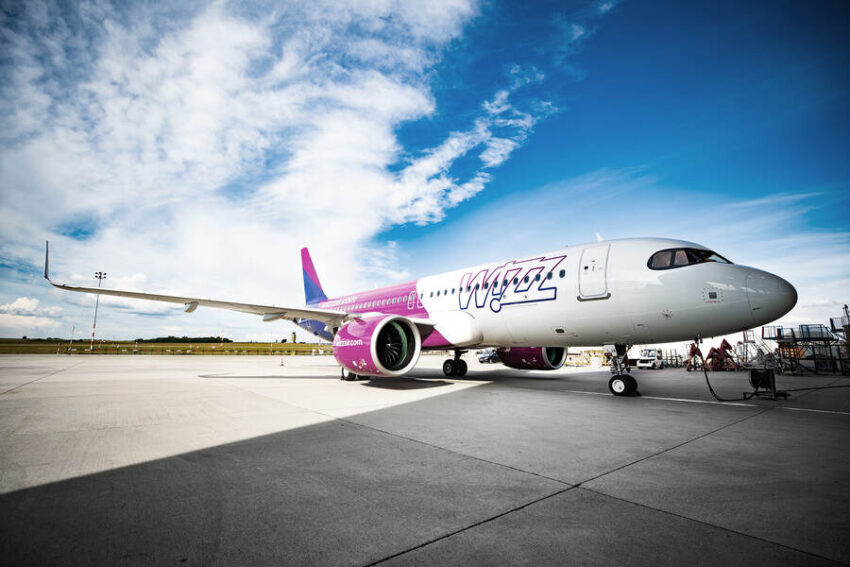Monday, July 14, 2025

Wizz Air‘s unexpected decision to retreat from Abu Dhabi on September 1, 2025, is the direct consequence of a culmination in ongoing problems which hindered their regional growth plan. The airline was subject to increasing geopolitical uncertainty, such as repeated airspace closures related to regional conflicts, which impacted operations, as well as demand. Compounding such issues were engine reliability problems related to the high heat in the Gulf region, further undermining aircraft reliability, as well as efficiency. Restrictive regulatory terms further inhibited market access, as well as expansion, rendering the low-cost model on which Wizz Air is based, ultimately, no longer viable.
As part of a major strategic refocusing, Wizz Air has formally confirmed that all operations under the Abu Dhabi-based subsidiary, Wizz Air Abu Dhabi, will cease on September 1, 2025. The decision is an indication of the rising impact on the long-term viability of the Middle Eastern low-cost air market from escalating geopolitical turbulence, regulatory holdbacks, and climatic restrictions. The move signals the end of the Hungarian airline’s four-year operational venture in the United Arab Emirates and highlights a decisive shift in its global strategy, now centered on reinforcing its presence across key European markets.
Strategic Retreat from the Gulf
Wizz Air’s withdrawal from Abu Dhabi International Airport is a significant resetting of its international presence. The carrier indicated clearly that the Middle East, previously viewed as a primary growth frontier, no longer serves in the long-term operating and financial template. Citing a litany of operative problems that grew ever more problematic through the years, Wizz Air officially confirmed that operations in Abu Dhabi will cease at the end of August 2025. The move signifies a decisive termination of the Wizz Air Abu Dhabi partnership, with all assets—including aircraft, staff, and operational infrastructure—being reallocated to the airline’s primary hubs across Central, Eastern, and select Western European regions.
This theatrical delay is the culmination of a long period of rising obstacles, which have included the decline in engine performance in the challenging regional climate, recurrent airspace closures due to regional conflicts, and an unfriendly regulatory environment that halted expansion plans.
Origins of the Enterprise and Deferred Dreams
Wizz Air Abu Dhabi commenced operations in the final months of 2020, entering the skies during a pivotal period of global aviation recovery following the severe downturn triggered by the COVID-19 pandemic. The airline was created as a joint venture between Wizz Air Holdings and ADQ—Abu Dhabi’s prominent investment entity—with a 51% stake held locally to meet regulatory compliance mandated by the United Arab Emirates.
As of launch, the subsidiary was imagined as a bold foray into the Middle Eastern air market. With an initial two Airbus A321neo airplanes, the carrier set about serving under-served and new markets across the Middle East, Africa, and the Indian subcontinent. Wizz Air Abu Dhabi quickly established itself in the regional aviation landscape by delivering direct, low-cost connections to distant destinations such as Oman, Bahrain, Egypt, and India, offering travelers affordable and efficient point-to-point travel options across the Middle East and South Asia.
The long-term strategy was nothing short of revolutionary. The Wizz Air plan was to stretch the Abu Dhabi-based fleet to 50 aircraft in the first few years of operations, advancing eventually to 100 aircraft in a 15-year period. The aggressive expansion plan was made possible on the shoulders of the parent international carrier’s expertise in scaling operations economically and profitably quickly, particularly in European markets.
However, the Middle Eastern venture was soon caught in an ever more fraught operating environment that tested even the strongest aviation business models.
Climate-Associated Technical Limitations
Also, the biggest threat in Wizz Air’s Middle Eastern strategy was the performance of the aircraft engine in the hot climate of the region. The largest operating fleet for Wizz Air Abu Dhabi, the A321neo, was most affected by reliability issues in long high-temperature operations characteristic in the Gulf.
The hot weather, which occasionally brought summer temperatures in the area as high as 45°C, imposed further stresses on airframe structures and powerplants. The normal weather brought higher maintenance requirements, reduced aircraft availability, and less effective operations. Such technical glitches harmed the typical cost-effectiveness characteristic of Wizz Air, which is based on high utilization of their planes and lean operations.
The inability of the airline to address these environment problems on a mass scale created long-term sustainability issues in the Middle East.
Barriers to Regulation and Market Constraints
Apart from technical issues, Wizz Air was faced with a series of regulatory and market-based challenges that frustrated further expansion in the Gulf area. While the airline had started operations on the premise of liberalized bilateral arrangements and open skies policies, reality was far less conducive.
Lack of market access, approval bottlenecks on routes, and complex licencing procedures in various jurisdictions created a web of regulatory friction. The conditions tempered the tempo of expansion and prevented Wizz Air Abu Dhabi from expanding as magnificently as expected.
Furthermore, local competition from established carriers, as well as stringent regulatory control, hindered Wizz Air in distinguishing itself on price alone. The factors worked together to undermine profit margins and threaten the sustainability of its model.
Geopolitical instability and airspace closures
Perhaps the most unexpected and destabilising factor in the exit strategy of Wizz Air from the region was the increased geopolitical instability. Throughout early 2025, a series of armed escalations in the Gulf furthered the complications for the operations of the airline.
One such point of inflection came when regional airspace was closed following a string of Qatar-bound missile attacks. Bahrain, Kuwait, and others closed their corridors of airspace in response, prompting mass cancellations and delays. Wizz Air Abu Dhabi, which provided a number of cross-border services, was most affected.
The carrier attempted normal operations as early as June 2025, but the protracted nature of the instability rendered such initiatives unsustainable. The cumulative impact of such disruptions not only affected passenger confidence but also introduced a very high degree of unpredictability in planning and scheduling routes.
As a result of reliance on lean operations and stable service provisioning by Wizz Air, such volatility was not aligned with its core business.
Focusing on Core Markets Again
Against the background of these compounding challenges, Wizz Air has made the strategic decision to consolidate operations in its most developed and successful markets. With that refocusing, the airline will concentrate its energies and attention on strengthening its bases in Hungary, Poland, Romania, Bulgaria, Austria, Italy, and the United Kingdom.
The carrier indicated the redistributed capacity from Abu Dhabi would be expected to further boost frequencies and new route additions in such European hubs. The move is consistent with general market tendencies that watch carriers optimizing markets in which regulatory clarity, operating consistency, as well as customer demand, are stable and predictable.
This new European focus is geared toward restoring operational resilience, protection of shareholder value, and stimulating the airline’s long-term growth curve.
Wizz Air’s Future Beyond the Gulf Region
Although Wizz Air is withdrawing from Abu Dhabi, the airline continues to explore alternative avenues for expanding its long-haul operations. The carrier previously suggested ahead of the withdrawal announcement that they would be interested in expanding operations to the Middle East and Asia from Europe based on their future Airbus A321XLR aircraft.
These long-haul narrowbodies will be able to facilitate a new point-to-point era in transocean travel, and they will possibly enjoy an economical advantage in long-haul travel to South Asian, Southeast Asian, and further points. The future impact on such plans due to the shutdown in Abu Dhabi is, as yet, unknown.
But the airline’s strategy appears to be to leverage its European bases as starting points for future long-haul expansion and not attempt to build loyal hubs in regions fraught with risk for operations.
Takeaways from the Abu Dhabi Exit
Wizz Air’s departure from Abu Dhabi is a humbling exemplar in the challenges of global aviation expansion. While the Middle East is a region that offers immensepotential due to its geography, economic development, and passenger demand, the region is also accompaniedby a challenging array of environmental, regulatory, and geopolitical variables.
Low-cost carriers, in particular, are most vulnerable in such markets where their lean cost structures do not offer much room for errors. Like in the case of Wizz Air, even well-capitalized and forward-thinking airlines must be agile and responsive to real-world stresses that can quickly erode profitability and sustainability.
The change also is a recognition of the importance of fleet deployment agility. Exchanging planes to less desirable markets is saving Wizz Air’s bottom line and putting the airline on a firmer course forward.
Industry Developments and Competitive Profile
Pulling out of Abu Dhabi can cause ripples in the regional air market for Wizz Air. The exit holds probable benefits for regional carriers to further expand their own low-cost businesses and fill in the market gaps left behind. However, it is also a precursor for further global entrants seeking to base themselves in such demanding scenarios.
Meanwhile, Wizz Air’s redeployment of assets to Europe could escalate rivalry in its home markets, notably among fellow budget airlines and expansionist legacy carriers building out low-cost franchises. Greater access to planes and crew is expected to accommodate new route openings and frequency increases, which would be positive for consumers in terms of reduced prices as well as increased connection.
Also, redeployment can accelerate the carrier’s adoption of newer technology, network efficiencies, and IT tools that are geared toward scaling and incorporating in-built resilience.
Future Directions
As Wizz Air readjusts its global strategy, maximizing profitability, enhancing the soundness of operations, and maintaining a competitive edge in an dynamically transforming airline market will be the focus. While closing down its Abu Dhabi base would be seen as moving in the wrong direction, in effect, it is a realistic move for matching resources against the competencies and fundamentals of the airline market.
Wizz Air is exiting Abu Dhabi due to escalating geopolitical turbulence, engine performance effects from hot climates, and restrictive regulations which scutted its regional expansion strategy. The challenges made further operations under a low-cost structure in the Middle East untenable.
In the long term, Middle Eastern experience can be transferred to future international expansion, as new markets in Asia, Africa, and possibly Latin America are considered on the basis of less rigid and dynamic models. Whether the carrier resumes operations in the Gulf region in a new configuration or shifts fully to outbound flows from its European bases, the Abu Dhabi experience will influence long-term strategic decisions.





